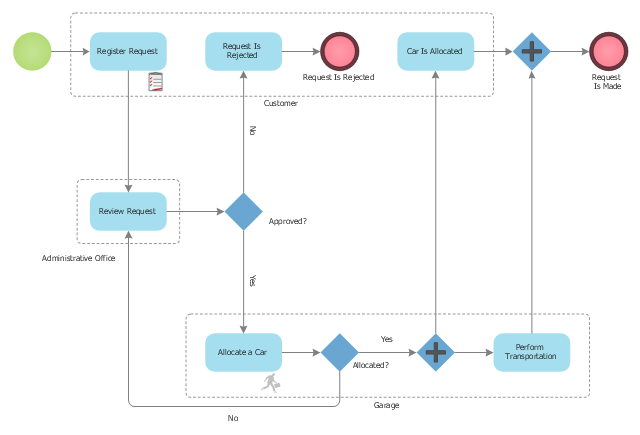"A business process or business method is a collection of related, structured activities or tasks that produce a specific service or product (serve a particular goal) for a particular customer or customers. It often can be visualized with a flowchart as a sequence of activities with interleaving decision points or with a Process Matrix as a sequence of activities with relevance rules based on data in the process. ...
There are three types of business processes:
(1) Management processes, the processes that govern the operation of a system. Typical management processes include "corporate governance" and "strategic management".
(2) Operational processes, processes that constitute the core business and create the primary value stream. Typical operational processes are purchasing, manufacturing, advertising and marketing, and sales.
(3) Supporting processes, which support the core processes. Examples include accounting, recruitment, call center, technical support. ...
The ... improvement areas are equally applicable to policies, processes and detailed procedures (sub-processes/ tasks). There is a cascading effect of improvements made at a higher level on those made at a lower level.
For instance, if a recommendation to replace a given policy with a better one is made with proper justification and accepted in principle by business process owners, then corresponding changes in the consequent processes and procedures will follow naturally in order to enable implementation of the policies" [Business process. Wikipedia]
The BPMN 1.2 (Business Process Model and Notation) diagram example "Taxi service order procedure" was created using the ConceptDraw PRO diagramming and vector drawing software extended with the Business Process Diagram solution from the Business Processes area of ConceptDraw Solution Park.
There are three types of business processes:
(1) Management processes, the processes that govern the operation of a system. Typical management processes include "corporate governance" and "strategic management".
(2) Operational processes, processes that constitute the core business and create the primary value stream. Typical operational processes are purchasing, manufacturing, advertising and marketing, and sales.
(3) Supporting processes, which support the core processes. Examples include accounting, recruitment, call center, technical support. ...
The ... improvement areas are equally applicable to policies, processes and detailed procedures (sub-processes/ tasks). There is a cascading effect of improvements made at a higher level on those made at a lower level.
For instance, if a recommendation to replace a given policy with a better one is made with proper justification and accepted in principle by business process owners, then corresponding changes in the consequent processes and procedures will follow naturally in order to enable implementation of the policies" [Business process. Wikipedia]
The BPMN 1.2 (Business Process Model and Notation) diagram example "Taxi service order procedure" was created using the ConceptDraw PRO diagramming and vector drawing software extended with the Business Process Diagram solution from the Business Processes area of ConceptDraw Solution Park.
 Target and Circular Diagrams
Target and Circular Diagrams
This solution extends ConceptDraw PRO software with samples, templates and library of design elements for drawing the Target and Circular Diagrams.
This enterprise architecture (EA) metamodel diagram example was redesigned from the illustration of article " helicopters and metamodels take 2".
"This is a “helicopter” level view – meant as a consulting and conversation guide for senior managers to help them place enterprise architecture appropriately in their strategic thinking."
www.achurchassociates.com/ 2012/ 10/ 16/ helicopters-and-metamodels-take-2/
from the website www.achurchassociates.com , with the kind permission of Ric Hayman.
The example "Enterprise architecture diagram" was created using the ConceptDraw PRO diagramming and vector drawing software extended with the Enterprise Architecture Diagrams solution from the Management area of ConceptDraw Solution Park.
"This is a “helicopter” level view – meant as a consulting and conversation guide for senior managers to help them place enterprise architecture appropriately in their strategic thinking."
www.achurchassociates.com/ 2012/ 10/ 16/ helicopters-and-metamodels-take-2/
from the website www.achurchassociates.com , with the kind permission of Ric Hayman.
The example "Enterprise architecture diagram" was created using the ConceptDraw PRO diagramming and vector drawing software extended with the Enterprise Architecture Diagrams solution from the Management area of ConceptDraw Solution Park.
- 5 level pyramid model diagram of information systems types ...
- Seven Management and Planning Tools | Matrices | SWOT analysis ...
- Successful Strategic Plan | Block Diagrams | Pyramid Diagram |
- Successful Strategic Plan | Management Tools Total Quality ...
- Porter's generic strategies matrix diagram | Successful Strategic Plan
- Marketing | Block diagram - Six markets model | Pyramid Diagram ...
- 3 level pyramid model diagram of information systems types | 5 level ...
- Pyramid Chart Examples | Brand essence model - Wheel diagram ...
- Pyramid Diagram
- Business Process Management | Business Process Modeling ...
- Manage Social Media Response Plan | Pyramid Diagram | Total ...
- 5 level pyramid model diagram of information systems types | 4 level ...
- What is Gantt Chart (historical reference) | Organizational Chart ...
- UML Collaboration Diagram Example Illustration | Beauty in nature ...
- Pyramid Chart Examples | Business Processes | Cross-Functional ...
- Pyramid Chart Examples | Cross-Functional Process Map Template ...
- Pyramid Diagram
- 3 level pyramid model diagram of information systems types | 4 level ...
- 5 level pyramid model diagram of information systems types
- Flowchart - HR management process

